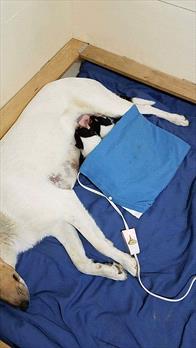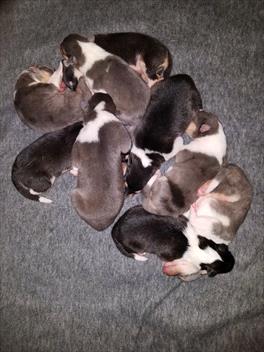Herpes litter survivors

Two collie puppies in this litter of five survived herpes. Photo by Chandra Flaim/VIN.
Solving the Mystery of the Disappearing Litter
Most of us are familiar with herpes viruses because we have heard of human herpes. Medications to suppress herpes outbreaks are advertised on television and educational programs are in place in schools and communities. People refer to periodically breaking out in herpes sores, either facial (Herpes I) or genital (Herpes II), indicating that symptoms are not constant but happen sporadically. Indeed, herpes is famous for its intermittent symptoms. Herpesviruses have the ability to “hide” in the body’s nerve ganglia, where they are safe from the immune system, periodically emerging and causing visible lesions. Herpes infection is generally considered to be permanent, with outbreaks of symptoms associated with stress.
In fact, our pets must deal with their own herpes viruses. In cats, herpes is a respiratory virus accounting for nearly half of feline upper respiratory infections. Feline herpes is contagious and a common problem wherever cats are housed in groups.
Canine herpes is more of a reproductive problem than a respiratory one; in fact, most infected dogs do not appear to get sick at all or have mild conjunctivitis/upper respiratory symptoms. It is the unborn and newborn for whom the virus is most serious.
Herpes infection in pregnancy causes resorption of the embryos, abortion of the fetuses, stillbirth, or death of puppies within a few weeks of life. Transmission occurs by direct contact (sexual contact will do it but the usual route is simply normal nosing, licking, and sniffing) between the infected and uninfected dogs. For this reason, a pregnant dog should be isolated from other dogs for the last three weeks of pregnancy and the first three weeks after birth. Let’s say that again:
Any pregnant dog should be isolated from other dogs for the last three weeks of pregnancy and the first three weeks after birth. If she gets infected during this period, the litter is likely to be lost.
There are two syndromes experienced by puppies, depending on their age at exposure. If the puppies are infected after the age of three weeks, a kennel cough type of respiratory infection ensues. This can be serious and can progress to pneumonia given the vulnerabilities of a puppy so small and young, but overall this syndrome is far better than what is experienced by much younger puppies.
Puppies exposed from birth to up to age three weeks develop a painful, rapidly progressive condition that typically results in death within 48 hours. Affected puppies are very vocal, and show abdominal bloating, difficult shallow breathing, cold body temperatures, and weakness. Low platelet counts associated with infection result in speckles called petechiae, which may or may not be externally visible. The entire litter may be quickly lost.
The reason why three weeks of age seems to be a critical age is that this is the age when puppies begin to be able to maintain their own body temperature. The canine herpes virus depends on a cooler body temperature to replicate, with 95F°/30°C being optimal. A warmer body temperature greatly hampers the spread of the virus. Keeping the litter cozy and warm is important in protecting and treating it.
What to do when one of the Puppies Dies Shortly after Birth
The necropsy (autopsy) is the only realistic means of finding out what happened. If you want to learn if the other litter members are at risk or if the mother dog can safely be bred again, the dead puppy should be examined.
- Place the remains in a zippered plastic food bag and refrigerate until you can notify your veterinarian. If the placenta is available, it should be included.
- Expect the mother dog and remaining littermates to be examined and the dead puppy to be necropsied.

Graphic by MarVistaVet
There are many causes for the loss of a near-term or newly born litter of puppies: coronavirus, parvovirus, toxoplasmosis, brucellosis, umbilical trauma, genetic disease, etc. Knowing what to do heavily depends on knowing what happened. Puppies that die from canine herpes have characteristic inclusion bodies in many tissues that can be seen under the microscope. Inclusion bodies are essentially areas of heavy virus reproduction that are actually visible and unique in appearance. The presence of herpes inclusion bodies confirms the diagnosis. Recently a PCR test (a test for herpesviral DNA) has been developed for dogs. This test is likely to become the diagnostic test of choice in a post-mortem puppy situation. In many individuals, the aforementioned speckling is on the kidneys. If this finding is detected, herpes is confirmed and microscopic tissue examination is probably not necessary.
Prior Exposure of the Mother Dog and Screening Tests
The reason why puppies get into trouble with the herpes virus is twofold: cool body temperature and lack of protection from their mother. Body temperature can be managed by keeping the nest area heated but if the mother was never infected, then she has no antibodies with which to protect her puppies. If she is infected in pregnancy, the litter is vulnerable or if the litter is exposed before the age of three weeks (from their mom or from any other visiting dog) again, they are vulnerable.
Herpes is an extremely common canine virus, and most social dogs who meet and greet other dogs will get infected. The mother dog who was exposed/infected a long time ago will have antibodies and her puppies should be protected regardless of her contact with other dogs. Herpes, however, is by no means the only infectious agent puppies must contend with so the recommendation for isolation stands even if herpes is not the virus in question. We do not want infectious agents attacking the litter before or after birth, regardless.
So should you test the mother during pregnancy? It may not be necessary if you are going to isolate the mother and litter anyway.
Should you test her at breeding? Probably not because her infection status could change by the time she gets to the final three weeks of pregnancy.
Should you test the male? If he is being used as a stud dog with any regularity, he has most likely been exposed already.
The test that is used to determine whether a dog is naive (never exposed or infected) or has prior exposure is a blood test for herpes antibodies. The idea is that if there are antibodies, the virus was there at some point to generate them. The ability of an infected dog to maintain antibodies against canine herpes is variable. Some infected dogs show no antibodies after a couple of months have passed since infection, and others have antibody levels persisting for years. This makes meaningful screening a challenge; it is safest to simply stick to the isolation of the mother dog and litter.
Collie puppies

Photo by Chandra Flaim/VIN
Saving the Infected Litter
Canine herpes is very bad news for puppies less than three weeks of age. Often there is nothing that can be done to stop the sweep of this lethal virus. This does not keep us from fighting, however. If a seropositive nursing female dog is available (i.e. a nursing mother who is known to have been previously exposed), the litter at risk can be moved to her. Alternatively, serum from a recovered female dog can be separated and injected into the puppies as a source of anti-herpes antibodies. Warming the puppies may help as the virus cannot survive at body temperature. Antiviral medications such as Acyclovir may help.
Prevention
As noted, canine herpes prefers a cooler body temperature of around 95F°/30°C for maximum replication. Keeping the nest box warm enough that the puppies are consistently warmer is helpful but one should note that the virus cannot live in an environment where the temperature drops below 68°F/20°C. Herpes is readily killed by common household disinfectants.
Be sure the litter nurses from the mother during the first day after birth so as to maximize intake of colostrum (the special antibody-rich first milk). Isolate the mother and pups as described above. In Europe, a vaccine is available for use during canine pregnancy (one dose at the time of breeding and a second six to seven weeks later, to be repeated with each pregnancy) but it is not available in the U.S.
Herpes is most dangerous to puppies when they are infected during pregnancy or shortly after delivery. Once the mother has been virus-exposed, subsequent pregnancies should be unaffected as she will have made enough antibodies to keep the virus in check. Her antibodies will keep her from re-shedding the virus to the puppies and will transfer to her milk to provide some protection to the puppies. While this means the mother dog should not be able to transmit the virus to her puppies, they can still be infected by other visiting dogs and the litter and mother must be isolated. Further, a mother dog with prior exposure may be able to re-shed the virus if she is stressed enough for the virus to break through her immunity.
To summarize:
- Canine herpes only causes symptoms in unborn or newborn puppies and they usually do not survive the infection.
- The mother dog will not appear sick or may show mild cold/respiratory symptoms only.
- Problems classically occur when an uninfected female becomes infected during pregnancy. Females infected long before pregnancy should not lose their litters to herpes as long the puppies are properly isolated.
- Herpes is a common canine infection and is spread not only by sexual contact but through mouth and nose fluids.